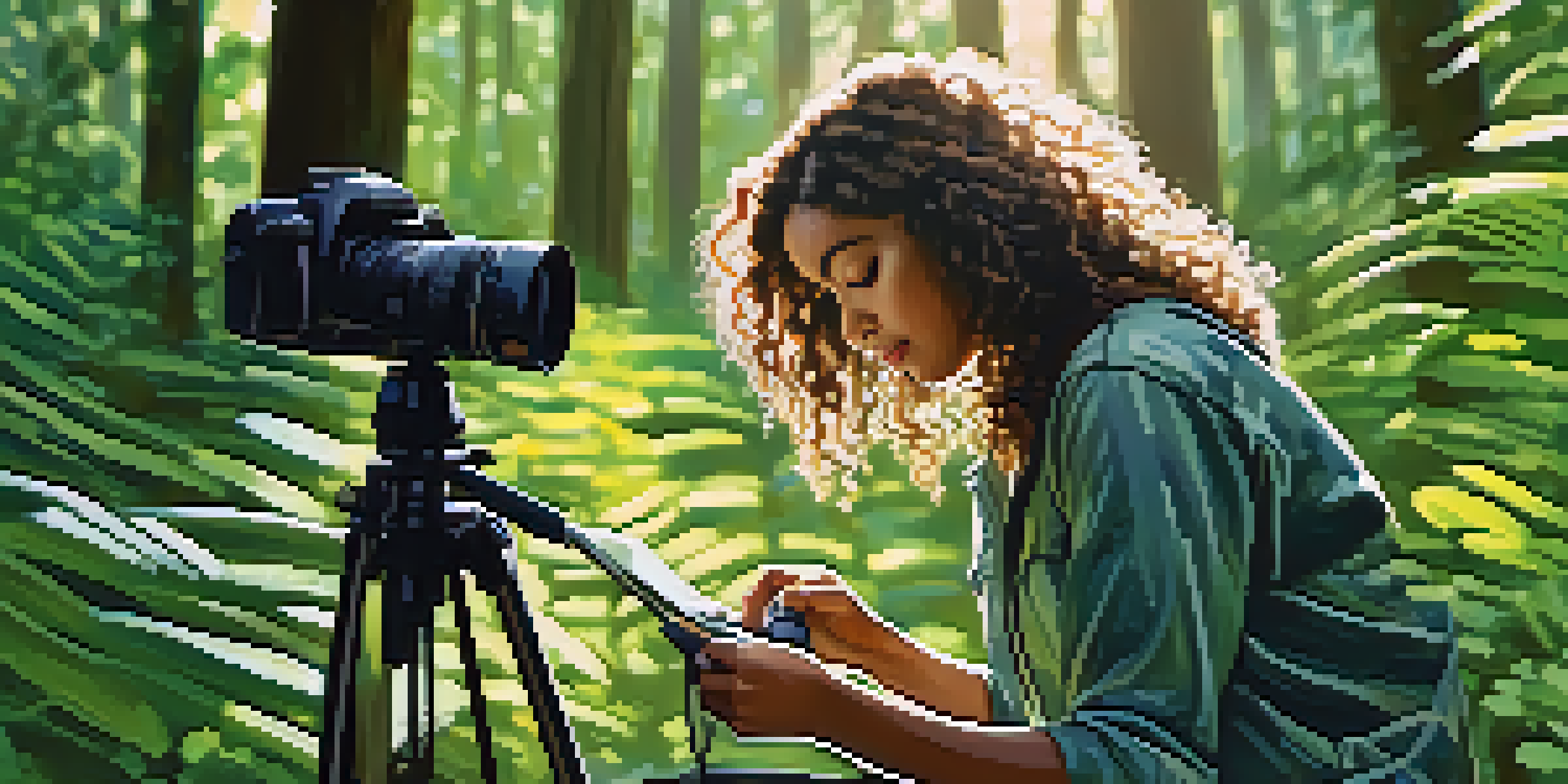Techniques in Documentary Filmmaking: A Comprehensive Guide

Understanding the Purpose of Documentary Filmmaking
Documentary filmmaking serves to inform, educate, and provoke thought. Unlike fictional films, documentaries seek to present reality, often highlighting social issues, histories, or personal stories. They invite viewers to question their perceptions and engage with real-world narratives.
Documentaries are stories that are true, and they are told in a way that makes people think, feel, and act.
The purpose of a documentary can vary widely; some aim to entertain while others strive to instigate change. For instance, a documentary about climate change might aim to raise awareness and inspire action, while one focused on a musician's life may simply seek to entertain and celebrate their work.
Ultimately, understanding the purpose behind your documentary will guide your creative decisions, from topic selection to storytelling techniques, ensuring that your film resonates with your audience.
Crafting Compelling Narratives in Documentaries
At the heart of every great documentary lies a compelling narrative. This narrative is constructed through a blend of interviews, visuals, and voiceovers, all working together to tell a cohesive story. A well-defined narrative arc helps to keep viewers engaged, guiding them through the film's structure.

Consider the classic structure of storytelling: exposition, rising action, climax, and resolution. Even in a documentary, these elements can be applied to create tension and interest. For example, a documentary about a social movement might start with the origins of the issue, build up to key events, and conclude with the current state of affairs.
Purpose of Documentaries
Documentaries aim to inform, educate, and provoke thought, often addressing social issues and real-world narratives.
Incorporating personal stories or testimonials can also enhance the narrative, making it more relatable and emotional. This approach allows viewers to connect personally with the subject matter, deepening their engagement.
Choosing the Right Interview Techniques
Interviews are a cornerstone of many documentaries, providing firsthand accounts and insights. The way interviews are conducted can greatly influence the film's tone and authenticity. Open-ended questions encourage more in-depth responses, allowing the interviewee to share their perspectives fully.
The power of documentary film is to illuminate the truth, to take you behind the scenes of the world.
Creating a comfortable environment for interviewees is essential. This can involve informal settings, friendly conversation, or even pre-interview chats to build rapport. When interviewees feel at ease, they are more likely to open up and share genuine emotions and experiences.
Additionally, consider varying the interview styles. Some segments might benefit from a traditional sit-down interview, while others could explore more dynamic formats, such as interviews conducted in the field, allowing viewers to see the context of the subject’s experiences.
Utilizing Visual Storytelling Techniques
Visual storytelling is a powerful tool in documentary filmmaking, as it can convey emotions and messages that words alone often cannot. This involves using diverse visuals—such as archival footage, photographs, and b-roll—to enrich the narrative and immerse viewers in the story.
The choice of visuals should align with the film’s tone and subject matter. For instance, a documentary about a war zone might utilize stark, dramatic imagery, while one about wildlife could focus on vibrant, stunning shots of nature. This creates an emotional connection and enhances the viewer's understanding.
Crafting Engaging Narratives
A compelling narrative is essential in documentaries, utilizing storytelling techniques like interviews and personal testimonials to engage viewers.
Moreover, employing techniques such as slow motion, time-lapse, or close-ups can add depth to the storytelling. These techniques emphasize specific moments and create a more immersive viewing experience.
The Role of Sound and Music in Documentaries
Sound design and music play crucial roles in setting the mood and tone of a documentary. Background music can evoke specific emotions, guiding the audience's feelings as they watch. A subtle, somber score might complement a serious topic, while upbeat music could enhance a more lighthearted segment.
Natural sound, or 'ambient sound,' is equally important in creating an authentic atmosphere. The sounds of the environment—like bustling streets, nature sounds, or even silence—can transport viewers to the documentary's setting, making the experience more visceral.
Additionally, including voiceovers or narration can help clarify points or provide context. A well-delivered voiceover can weave together different segments of the film, ensuring a smooth narrative flow.
Editing Techniques for Impactful Storytelling
Editing is where the magic happens in documentary filmmaking; it's where raw footage transforms into a cohesive story. The editing process involves selecting the best takes, building the narrative structure, and ensuring that pacing keeps viewers engaged. Effective editing can create suspense, emotion, and clarity.
One technique is the use of juxtaposition, where contrasting images or sounds are placed together to create meaning. For example, showing a thriving community followed by images of its decline can highlight the impact of social issues. This can provoke thought and deepen the viewer's understanding.
Ethical Filmmaking Practices
Ethics in documentary filmmaking is crucial, ensuring respect, accuracy, and representation for subjects and audiences alike.
Moreover, transitions play a vital role in maintaining flow. Smooth transitions between scenes can enhance the storytelling, while abrupt cuts can create tension or surprise, depending on the desired effect.
Incorporating Ethical Considerations in Filmmaking
Ethics in documentary filmmaking is paramount, as filmmakers have a responsibility to their subjects and audiences. This includes obtaining informed consent from interviewees and being transparent about the film's intent. Ethical considerations ensure that the stories told are respectful and accurate.
Additionally, being mindful of representation is crucial. Filmmakers should strive for authenticity and avoid perpetuating stereotypes. This involves giving voice to marginalized communities and portraying them in a nuanced, respectful manner.

Ultimately, ethical filmmaking fosters trust and credibility, both with subjects and audiences. By prioritizing ethics, filmmakers can create impactful stories that resonate and inspire positive change.